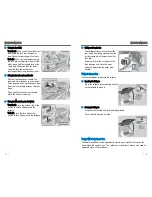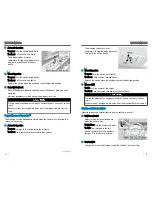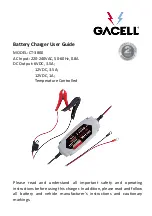
n
Safety Messages
When you see the following messages throughout this guide, pay close
attention.
You WILL be KILLED or SERIOUSLY HURT if you don’t
follow instructions.
You CAN be KILLED or SERIOUSLY HURT if you don’t
follow instructions.
You CAN be HURT if you don’t follow instructions.
This information is intended to help you avoid damage to
your vehicle, other property, or the environment.
n
Carbon Monoxide Gas
The engine exhaust from this vehicle contains carbon monoxide, a
colorless, odorless, and highly toxic gas. As long as you properly maintain
your vehicle and follow the instructions set forth below, you will not
accumulate dangerous levels of carbon monoxide gas in the vehicle interior.
Have the exhaust system inspected for leaks whenever:
• The exhaust system is making an unusual noise.
• The exhaust system may have been damaged.
• The vehicle is raised for an oil change.
When you operate a vehicle with the tailgate open, airflow can pull exhaust
gas into the interior and create a hazardous condition. If you must drive with
the tailgate open, open all the windows and set the climate control system
as shown below:
1. Select the fresh air mode.
2. Select the mode.
3. Set the fan speed to high.
4. Set the temperature control to a comfortable setting.
Adjust the climate control system in the same manner if you sit in your
parked vehicle with the engine running.
Carbon monoxide gas is toxic. Breathing it can cause unconsciousness
and even kill you. Avoid any enclosed areas or activities that expose you to
carbon monoxide.
An enclosed area such as a garage can quickly fill up with carbon monoxide
gas. Do not run the engine with the garage door closed. Even when the
SAFETY INFORMATION
4 |
garage door is open, drive out of the garage immediately after starting the
engine.
Seat Belts
A seat belt is your best protection in all types of collisions. Airbags are designed
to supplement seat belts, not replace them. So even though your vehicle is
equipped with airbags, make sure you and your passengers always wear your
seat belts and wear them properly.
n
Lap/Shoulder Seat Belts
All five seating positions are equipped with lap/shoulder seat belts with
emergency locking retractors. In normal driving, the retractor lets you move
freely while keeping some tension on the belt. During a collision or sudden
stop, the retractor locks to restrain your body. The front passenger's
andrear seat belts also have a lockable retractor for use with child seats.
n
Proper Use of Seat Belts
Follow these guidelines for proper use:
• All occupants should sit upright, well back in the seat, and remain in the
position for the duration of the trip. Slouching and leaning reduces the
effectiveness of the belt and can increase the chance of serious injury in
a crash.
• Never place the shoulder part of a lap/shoulder seat belt under your arm
or behind your back. This could cause very serious injuries in a crash.
• Two people should never use the same seat belt. If they do, they could be
very seriously injured in a crash.
• Do not put any accessories on the seat belts. Devices intended to
improve comfort or reposition the shoulder part of a seat belt can reduce
the protective capability and increase the chance of serious injury in a
crash.
• No one should sit in a seat with an inoperative seat belt or one that does
not appear to be working correctly. Using a seat belt that is not working
properly may not protect the occupant in a crash. Have a dealer check
the belt as soon as possible.
Not wearing a seat belt properly increases the chance of a serious injury
or death in a crash, even though your vehicle has airbags.
Be sure you and your passengers always wear seat belts and wear them
properly.
SAFETY INFORMATION
| 5







































